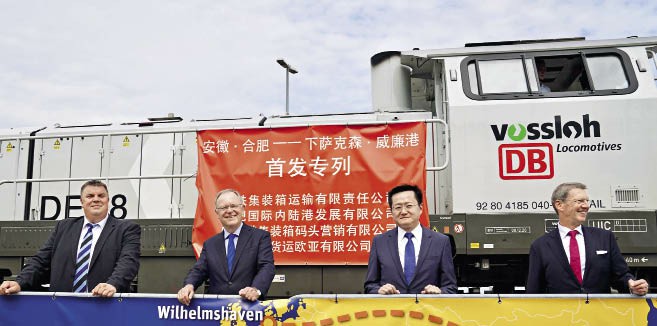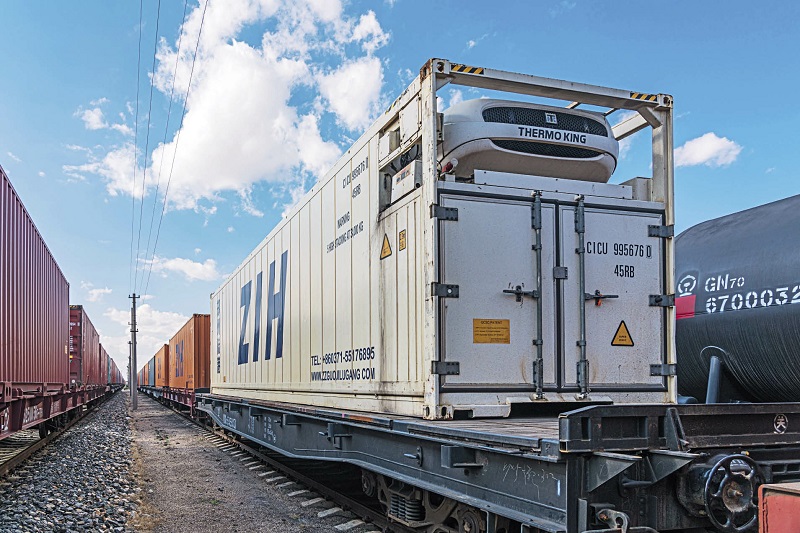As the U.S. launched the initiative Build Back Better World (B3W) at the G7 Summit in June, global infrastructure construction has once again become the world’s focus, sparking much discussion. The essence of connectivity construction has always been based on cooperation and win-win outcomes, and the EU’s recently approved conclusions on “A Globally Connected Europe” also shows that China and the EU still have huge potential on the issue of interconnection going forward.

A direct freight train starting from China’s Anhui Province arrives in Wilhelmshaven, Niedersachsen, Germany, for the first time on July 13, 2021.
Cooperation at the Core
Since the Belt and Road Initiative (BRI) was put forward in 2013, connectivity construction has always been a key topic in global public policy discussions. However, the sudden outbreak of the COVID-19 pandemic disrupted the operating mode and path of globalization, while simultaneously bringing new challenges to global connectivity construction initiatives such as the BRI.
In the long term, connectivity construction is still a crucial element required to improve development of various countries, and it is also the intersection for the interests of governments, enterprises and people. The BRI and other connectivity solutions will bring capital, technology, management expertise, and other resources to more developing countries including less developed countries, and promote balanced regional development, thereby bringing new impetus to regional and global trade, investment, and environmental governance.
In this process, various problems such as uneven distribution of interests of different parties, mismatch of governance philosophies, and conflicts of cultural concepts appear. They are inevitable for any international plan or initiative. Whether it’s the BRI, which was first proposed eight years ago, or the newly established B3W, from the macro perspective of the process of human history, or considering the vast projects required for the connectivity construction, they are still “newborns.” Many urgent problems still need to be solved.
Therefore, on this course, all parties should take the mission of advancing regional development as a common starting point. It is necessary to regard competition as a means to promote regional development, rather than as an end. Only in this way can the various initiatives truly create value for the construction process and meet the needs of regional development.
Promoting Connectivity
The EU is an active engine and participant in the construction of regional and Eurasian connectivity. Regional interconnection is a vital foundation and the result of European integration. Since the dawn of the 21st century, the EU has also gradually worked on plans to connect with its surrounding areas. In October 2018, the EU officially announced its Euro-Asian connectivity strategy before the 12th Asia-Europe Meeting. The EU’s newly announced initiative, A Globally Connected Europe, is an upgraded version of the strategy in 2018.
China and the EU have been communicating, connecting, and cooperating on the issue of Asia-Europe connectivity for a long time. Soon after the BRI was put forward in 2013, in the Joint Statement: Deepening the China-EU Comprehensive Strategic Partnership for Mutual Benefit released in early 2014, the two parties decided to develop synergies between EU policies and the BRI. Since then, China and the EU have actively promoted the integration of the EU’s Junker Plan, aimed at strengthening investment in various fields, with the BRI, and established a China-EU connectivity platform in 2015. In its 2018 connectivity strategy, the EU also clearly stated that it needs to strengthen dialogue and seek synergy with China on Asia-Europe connectivity, and use the Asia-Europe Meeting platform for discussions with many countries in Asia and Europe, including China, on policy synergy and pragmatic cooperation. After the outbreak of the COVID-19 pandemic, Chinese and European leaders expressed their expectations for further strengthening bilateral connectivity.
Over the past eight years, China and the EU have actively cooperated in the fields of policies, facilities, trade, capital, and public support, and promoted the connectivity construction of Eurasia. The financial institutions of the two parties signed a memorandum of cooperation to provide investment and financing support for enterprises to participate in the BRI. The trade ties between China and the EU are even closer.
During the first half of 2021, China-EU trade was more than US $388.2 billion according to Chinese statistics, an increase of 37 percent. The trade between China and Germany increased by more than 35 percent this year. Growth in trade between China and France exceeded 43.9 percent, and that between China and Spain surpassed 35 percent. Even in the current difficult times, Sino-European trade is still flourishing.
The supporting role of the China-Europe freight train is indispensable, being a fruitful result of the BRI and Asia-Europe connectivity. After experiencing early doubts about high government subsidies, the freight train has demonstrated its true value since the outbreak of the COVID-19 pandemic. When global trade and transportation was greatly impacted in 2020, a record of 12,400 freight train trips were made between China and Europe, up 50 percent on a yearly basis. They carried 1.14 million TEU (20-foot equivalent unit), up 56 percent from 2019. The freight train has become the “lifeline” for fighting the pandemic, stabilizing the economy, promoting development in the Asia-Europe region, and driving regional economic and trade growth.
In addition to cooperation, the EU has also been forthright in giving its advice on issues about the BRI. During the process of communicating with European friends, I have heard many suggestions and opinions on the initiative. For example, the project database is not open enough, the operation is not transparent, and certain projects do not meet the EU’s environmental and labor standards. These issues are worthy of consideration and corresponding actions by the Chinese government and participating companies. The EU’s concept of green and sustainable development has also been recognized and adopted, which has become an important criterion for assessing the BRI today.

The China-Europe freight train route that starts in Zhengzhou, Henan Province resumes normal operations on July 27, 2021.
Exploiting Cooperation Potential
The EU Foreign Affairs Council approved conclusions on “A Globally Connected Europe” in July, which sent some confusing signals to China. First, the launch of the initiative closely follows the U.S. initiative B3W that was unveiled at the G7 Summit, attempting to build momentum for the U.S. to exert pressure on China.
Second, as for the content, although it is an upgraded version of the Euro-Asian connectivity strategy in 2018, it has stepped back when it comes to the issue of cooperation with China. This reflects the conservative approach to China-related issues within the EU under U.S. pressure.
Third, the speech made by German Foreign Minister Heiko Maas at the EU Foreign Affairs Council meeting reflected the tendency of G7 countries in the EU, such as Germany and France, to turn EU initiatives into “political tools” for their own strategic considerations.
However, the advancement of the BRI and the pragmatic cooperation between China and the EU in connectivity construction are still the dominant trend. After the initiative was released, Chinese State Councilor and Foreign Minister Wang Yi met with High Representative of the EU for Foreign Affairs and Security Policy Josep Borrell Fontelles in Tashkent, capital of Uzbekistan.
Wang pointed out that China welcomes the EU’s initiative on global connectivity. Some people claim that the EU’s initiative is intended to confront the BRI proposed by China. The Chinese side does not think the EU is so narrow-minded. Borrell said that the EU’s connectivity initiative is by no means a confrontation with the BRI. The EU is willing to strengthen coordination with China to align the EU’s connectivity initiative with the BRI. Both sides have reached consensus on the communication and coordination of connectivity initiatives.
In the future, China and the EU still have great untapped potential in the construction of connectivity between Asia, Europe, and the rest of the world. Wang and Borrell met at a high-level international conference themed “Central and South Asia: Regional Connectivity, Challenges and Opportunities,” which reflects the common concern of China and the EU on the connectivity construction in Central and South Asia. The two sides also have a high degree of consensus on green and sustainable development issues. How to promote the implementation of standards on the projects is the subject that both parties can discuss.
As long as the EU treats regional and global connectivity construction in a pragmatic and peaceful manner, it can work with China to do a good job in regional connectivity construction. The EU has significant comparative advantages in many fields, such as technology, management, and operation. As long as the two sides make good use of their respective advantages and integrate them, regional connectivity can be further improved, and it will bring increased benefits to China, the EU and even the entire Asia-Europe region.
HU HONG is a research assistant at China Institute of International Studies.